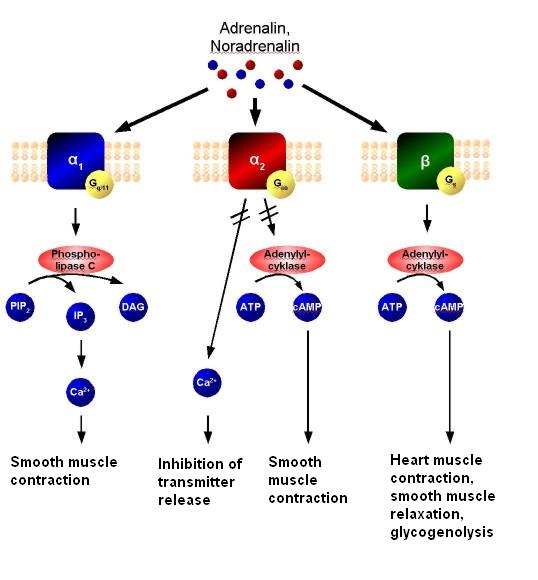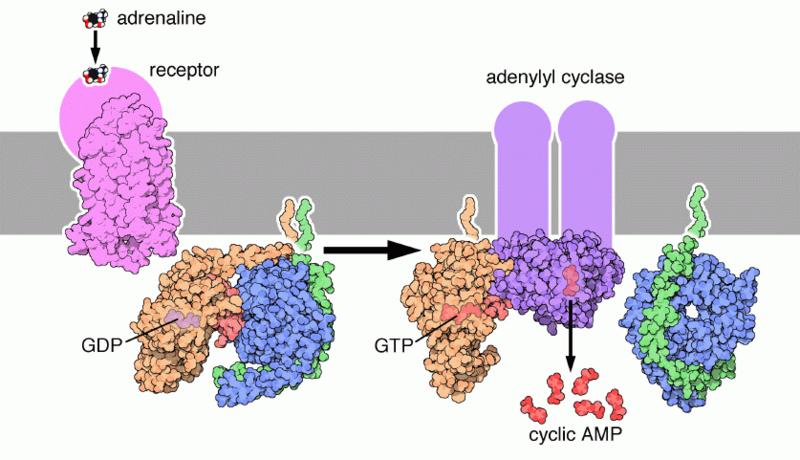Adrenergic receptor: Difference between revisions
m (Bot: Automated text replacement (-{{SIB}} + & -{{EH}} + & -{{EJ}} + & -{{Editor Help}} + & -{{Editor Join}} +)) |
m (Robot: Automated text replacement (-{{WikiDoc Cardiology Network Infobox}} +, -<references /> +{{reflist|2}}, -{{reflist}} +{{reflist|2}})) |
||
| Line 185: | Line 185: | ||
* {{cite book | first = | last =Rang HP, Dale MM, Ritter JM, Moore PK| authorlink = | coauthors = | year = 2003| month = | title = Pharmacology | chapter = Ch. 11| editor = | others = | edition = | pages = | publisher = Elsevier Churchill Livingstone| location = | id = ISBN 0-443-07145-4| url = }} | * {{cite book | first = | last =Rang HP, Dale MM, Ritter JM, Moore PK| authorlink = | coauthors = | year = 2003| month = | title = Pharmacology | chapter = Ch. 11| editor = | others = | edition = | pages = | publisher = Elsevier Churchill Livingstone| location = | id = ISBN 0-443-07145-4| url = }} | ||
* {{cite book | first = | last =Rang HP, Dale MM, Ritter JM, Flower RJ| authorlink = | coauthors = | year = 2007| month = | title = Rang and Dale's Pharmacology | chapter = Ch. 11| editor = | others = | edition = | pages = 169-170 | publisher = Elsevier Churchill Livingstone| location = | id = ISBN 0-443-06911-5| url = }} | * {{cite book | first = | last =Rang HP, Dale MM, Ritter JM, Flower RJ| authorlink = | coauthors = | year = 2007| month = | title = Rang and Dale's Pharmacology | chapter = Ch. 11| editor = | others = | edition = | pages = 169-170 | publisher = Elsevier Churchill Livingstone| location = | id = ISBN 0-443-06911-5| url = }} | ||
{{reflist}} | {{reflist|2}} | ||
==External links== | ==External links== | ||
Latest revision as of 14:11, 4 September 2012
Editor-In-Chief: C. Michael Gibson, M.S., M.D. [1]


The adrenergic receptors (or adrenoceptors) are a class of G protein-coupled receptors that are targets of the catecholamines. Adrenergic receptors specifically bind their endogenous ligands, the catecholamines adrenaline and noradrenaline (called epinephrine and norepinephrine in the United States), and are activated by these.
Many cells possess these receptors, and the binding of an agonist will generally cause a sympathetic response (ie the fight-or-flight response). For instance, the heart rate will increase and the pupils will dilate, energy will be mobilized, and blood flow diverted from other organs to skeletal muscle.(Note: Sympathetic activity will result in vasodilation of coronary arteries via the beta-2 adrenergic receptors.)
Subtypes

There are several types of adrenergic receptors, but there are two main groups: α-Adrenergic and β-Adrenergic.
- α receptors bind norepinephrine and epinephrine, though norepinephrine has higher affinity. Phenylephrine is a selective agonist of the α receptor. They exist as α1-adrenergic receptors and α2-adrenergic receptors.
- β receptors are linked to Gs proteins, which in turn are linked to adenylyl cyclase. Agonist binding thus causes a rise in the intracellular concentration of the second messenger cAMP. Downstream effectors of cAMP include cAMP-dependent protein kinase (PKA), which mediates some of the intracellular events following hormone binding.
Comparison
The absence of "ADRA1C" is intentional. At one time, there was a subtype known as C, but was found to be one of the previously discovered subtypes. To avoid confusion, it was decided that there would never be a C subtype again and so if any new subtypes were discovered, naming would start with D.
α receptors
α receptors have several functions in common, but also individual effects. Common effects include:
- Vasoconstriction of arteries to kidney (renal artery), heart (coronary artery), viscera, brain, erectile tissue and salivary glands.
- Vasoconstriction of veins
- Decrease motility of smooth muscle in gastrointestinal tract
- Contractions in male genitalia during ejaculation
α1 receptor
Specific actions of the α1 receptor include:
- Smooth muscle contraction in:
- ureter
- hairs (arrector pili muscles)
- uterus (when pregnant)
- urethral sphincter
- ureters
- bronchioles (although minor to the relaxing effect of β2 receptor on bronchioles)
- urinary bladder contraction[1][2]
- Smooth muscle relaxation in:
- Positive ionotropic effect on heart muscle[1].
- Secretion from salivary gland[1].
- Increase salivary potassium levels.
- Glycogenolysis and gluconeogenesis from adipose tissue [1] and liver.
- Secretion from sweat glands [1].
α2 receptor
Specific actions of the α2 receptor include:
- Mediates synaptic transmission in pre- and postsynaptic nerve terminals.
- Inhibition[3] of lipolysis in adipose tissue[1].
- Aggregation of platelets
- contraction of sphincters of the gastrointestinal tract
β receptors
As with α receptors, there are common actions of all β receptors, in addition to specific actions of each subtype. Common actions include:
- Stimulation of viscous, amylase-filldes secretions from salivary glands.
β1 receptor
Specific actions of the β1 receptor include:
- Increase cardiac output
- Increase heart rate [1] in sinoatrial node (SA node) (chronotropic effect)
- Increase atrial cardiac muscle contractility. (inotropic effect)
- Increases contractility and automaticity[1] of ventricular cardiac muscle.
- Increases conduction and automaticity[1] of atrioventricular node (AV node)
- Renin release from juxtaglomerular cells[1].
- Receptor also present in cerebral cortex.
β2 receptor
Specific actions of the β2 receptor include:
Muscular system
- Smooth muscle relaxation in uterus (when non-pregnant)[1], GI tract[1], blood vessels[1] and bronchi[1] (agonists can be useful in treating asthma)
- Relax urinary sphincter.
- Relax detrusor urinae muscle of bladder wall
Circulatory system
- Increase cardiac output (minor degree compared to β1.
- Increase heart rate [1] in sinoatrial node (SA node) (chronotropic effect)
- Increase atrial cardiac muscle contractility. (inotropic effect)
- Increases contractility and automaticity[1] of ventricular cardiac muscle.
- Dilate hepatic artery
- Dilate arteries to skeletal muscle
digestive system
- Glycogenolysis and gluconeogenesis in liver[1].
- Glycogenolysis and lactate release in skeletal muscle[1].
- Contract sphincters of GI tract
- Thickened secretions from salivary glands[1].
Other
- Inhibit histamine-release from mast cells
- Increase protein content of secretions from lacrimal glands
- Receptor also present in cerebellum.
The 3D structure of β2-Adrenergic receptor has been determined [2].
β3 receptor
Specific actions of the β3 receptor include: Enhance lipolysis in adipose tissue.
Diagrams

See also
References
- Rang HP, Dale MM, Ritter JM, Moore PK (2003). "Ch. 11". Pharmacology. Elsevier Churchill Livingstone. ISBN 0-443-07145-4.
- Rang HP, Dale MM, Ritter JM, Flower RJ (2007). "Ch. 11". Rang and Dale's Pharmacology. Elsevier Churchill Livingstone. pp. 169–170. ISBN 0-443-06911-5.
- ↑ 1.00 1.01 1.02 1.03 1.04 1.05 1.06 1.07 1.08 1.09 1.10 1.11 1.12 1.13 1.14 1.15 1.16 1.17 1.18 1.19 1.20 1.21 1.22 Neuroscience (Purves), Third Edition, table 20:2
- ↑ Excitatory alpha1-adrenergic receptors predominate over inhibitory beta-receptors in rabbit dorsal detrusor: "alpha1-AR subtypes responsible for norepinephrine induced contraction of rabbit dorsal detrusor smooth muscle". Chou EC, Capello SA, Levin RM, Longhurst PA.
- ↑ Inhibition of the lipolytic action of beta-adrenergic agonists in human adipocytes by alpha-adrenergic agonists EE Wright and ER Simpson
- ↑ Dysfunction in the beta 2-adrenergic signal pathway in patients with insulin dependent diabetes mellitus (IDDM) and unawareness of hypoglycaemia. Trovik TS, Vaartun A, Jorde R, Sager G.. Eur J Clin Pharmacol. 1995;48(5):327-32. PMID: 8641318
External links
- The Adrenergic Receptors
- IUPHAR GPCR Database - Adrenoceptors
- Basic Neurochemistry: α- and β-Adrenergic Receptors
- Brief overview of functions of the beta-3 receptor
- Theory of receptor activation
- Desensitization of beta-1-receptors
- UMich Orientation of Proteins in Membranes protein/pdbid-2rh1 - 3D structure of beta-2 adrenergic receptor in membrane